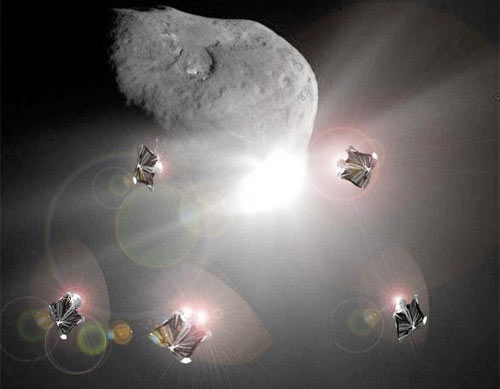Deflect meteorites with ... mirrors
According to research by Scottish scientists, using mirrors in space to focus sunlight on meteors is the best way to deflect the orbits of dangerous objects on Earth.
The research team at Glasgow University, Scotland, under the guidance of Professor Massimiliano Vasile, compared many methods of deflecting meteorites, including the use of nuclear weapons. Those methods are evaluated according to three criteria: the level of changes in meteorite trajectories; advance warning time is required; and the amount of spacecraft suitable for use.
After analyzing and evaluating the methods, Scottish experts say that using the mirror system in the universe is the best solution.
In this way, the spacecraft will be launched from the Earth to reach the asteroid, then the mirror on the ship will focus the sun on the selected locations on the asteroid surface. Sunlight reflected through the mirror system will heat the meteorite surface to a temperature of up to 2,100 ° C, enough to evaporate it. Then, gases escaping from the meteorite surface will create a repulsive force that changes its movement direction.

According to Scottish experts, the best solution to deflect dangerous objects is to use mirrors in the universe.(Photo: space.newscientist.com)
The team thinks it is possible to adjust the direction of a meteor with a diameter of 150 meters with 100 mirrors within a few days. But for objects with a diameter of 20 km - as in the case of extinction of dinosaurs - 5,000 mirrors need to be used for a period of 3 years or more.
According to Professor Vasile, this research is not a science fiction story, but a scientific reality.
He said: 'This solution is feasible and is within our reach. Unlike plans to use explosives to impact or use a spacecraft to crash directly into a meteorite, this option helps the Earth avoid danger from meteorite fragments when it explodes. '
He stressed: 'Colliding with asteroids is a real threat. The incident in Tunguska in 1908 devastated an area larger than Greater London. With 10 spacecraft - each weighing about 500 kg and carrying a 20-meter-wide mirror, we can completely deflect an object like that '.
According to experts, asteroids with a diameter greater than 5 km rush into the Earth every 6 million years. But for smaller meteorites (about 140 meters), that frequency is only 5,000 years once, and when such an incident occurs, the damage to the Earth is unpredictable.
Professor Vasile and his colleagues introduced this new method at the Jodrell Bank Observatory in Macclesfield (England), on the occasion of the 50th anniversary of the recent Sputnik launch (October 4, 1957).

The meteorite that hits the Earth will cause unforeseen damage.(Photo: solarvoyager.com)
Quang Thinh
- NASA: Deflect meteorites with nuclear weapons
- The history of mirrors
- 8000 year history of mirrors
- Mirror 'god' enlightens people to see organs
- Create a center to deflect meteorites
- Russia will prevent meteorites from crashing into the earth
- The surface of the 'giant' meteorite landed on Earth
- Why are mirrors in the elevator often fitted?
- Strange mysteries around the mirror
- The special mirror turned sad face into joy
- The origin and name of meteorite
- 'Fighting' with anti-meteorite 'apocalypse'
 Van Allen's belt and evidence that the Apollo 11 mission to the Moon was myth
Van Allen's belt and evidence that the Apollo 11 mission to the Moon was myth The levels of civilization in the universe (Kardashev scale)
The levels of civilization in the universe (Kardashev scale) Today Mars, the sun and the Earth are aligned
Today Mars, the sun and the Earth are aligned The Amazon owner announced a secret plan to build a space base for thousands of people
The Amazon owner announced a secret plan to build a space base for thousands of people